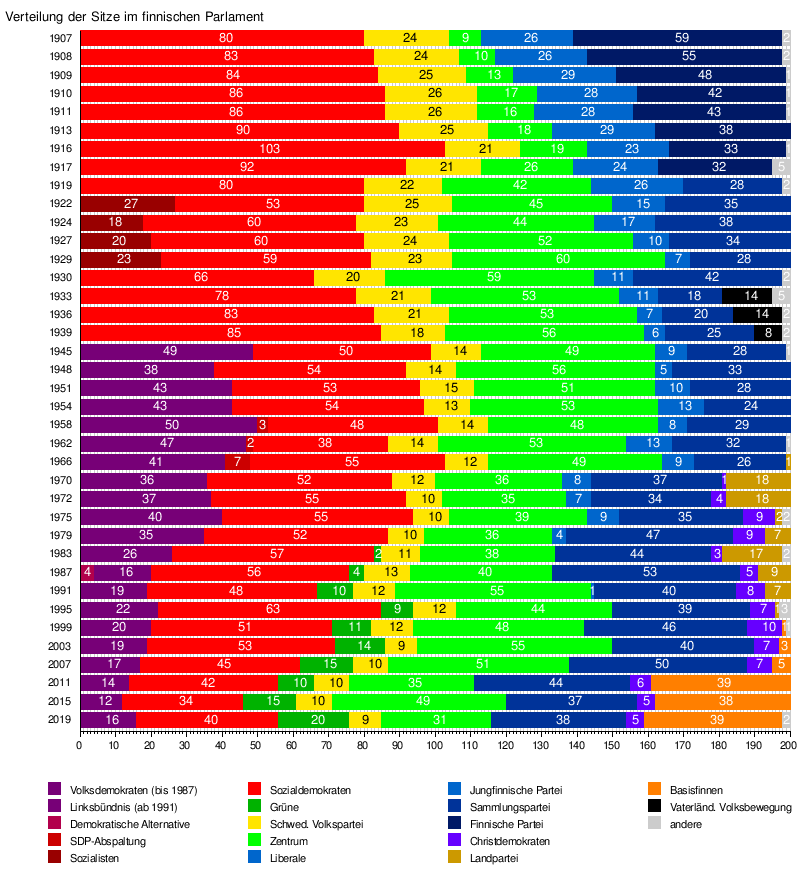Finnish Parliament
| logo | Parliament building |
|---|---|
|
|

|
| Basic data | |
| Seat: | Helsinki |
| Legislative period : | 4 years |
| First session: | May 25, 1907 |
| MPs: | 200 |
| Current legislative period | |
| Last choice: | April 14, 2019 |
| Next choice: | probably 2023 |
| Chair: |
President of Parliament Matti Vanhanen ( KESK ) |
| Distribution of seats: |
|
| Website | |
| web.eduskunta.fi | |

The Finnish Parliament ( Finnish eduskunta, literally. Representatives shaft representative ; Swedish Riksdagen , literally. Reichstag ) is a single chamber - Parliament with 200 deputies and is based in Helsinki . The President of Parliament has been Matti Vanhanen since June 2019 .
Constitution
According to the Finnish constitution , the parliament represents the people and exercises legislative power . It also decides on the state budget , ratifies international treaties and monitors the work of the government . It can change the constitution, dismiss the Government and the veto of the President overrule. Parliament has to approve constitutional amendments twice, in two consecutive legislative periods.
Suffrage
In 1906 Finland introduced universal, equal, free and direct suffrage for women and men. Finland was the first country in Europe to grant women the right to vote, and the Finnish parliament was the first national parliament in the world to which women were elected.
Citizens of Finnish nationality aged 18 and over are entitled to vote; even those who live abroad all the time. The representatives are elected for four years according to proportional representation. For the Reichstag election, Finland is divided into 13 constituencies . The number of MPs in a constituency is determined by its population, with the exception of Åland , which always has one MP. The mandates are distributed according to the D'Hondt procedure , with the voters deciding which candidate from their preferred party they vote for. There is no explicit threshold clause , but due to the number of seats allocated in the constituencies, a party still needs a fluctuating minimum number of votes in order to receive a mandate.
The election day was from 1966 to 2007 with regular elections in March , 2011 and 2015 were elected in April .
Last choice
Allocation of seats since 1907

building

The Reichstag building (Finnish eduskuntatalo , Swedish riksdagshuset ) is located in central Helsinki on Mannerheimintie street . The building was designed in the neoclassical style by the architect Johan Sigfrid Sirén . Construction began in 1926 and the official opening took place on March 7, 1931. In 1978 the parliament was expanded to include a three-part building complex. Modern parliamentary offices, a visitor center and a much frequented restaurant are located in the most recent extension from 2004, the so-called Small Parliament ( pikkuparlamentti , lilla parlamentet ) .
Individual evidence
- ^ Oskar Niedermayer, Richard Stöss, Melanie Haas: The party systems of Western Europe. VS Verlag für Sozialwissenschaften, Wiesbaden 2006, p. 145.
Web links
- Finnish Parliament Official website (Finnish, Swedish, English, French)
- History of the Finnish Parliament (Finnish, Swedish, English)
Coordinates: 60 ° 10 ′ 21 ″ N , 24 ° 55 ′ 58 ″ E


